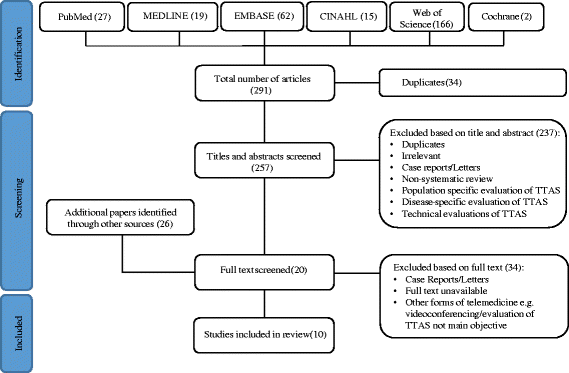The quality, safety and governance of telephone triage and advice services - an overview of evidence from systematic reviews
- PMID: 28854916
- PMCID: PMC5577663
- DOI: 10.1186/s12913-017-2564-x
The quality, safety and governance of telephone triage and advice services - an overview of evidence from systematic reviews
Abstract
Background: Telephone triage and advice services (TTAS) are increasingly being implemented around the world. These services allow people to speak to a nurse or general practitioner over the telephone and receive assessment and healthcare advice. There is an existing body of research on the topic of TTAS, however the diffuseness of the evidence base makes it difficult to identify key lessons that are consistent across the literature. Systematic reviews represent the highest level of evidence synthesis. We aimed to undertake an overview of such reviews to determine the scope, consistency and generalisability of findings in relation to the governance, safety and quality of TTAS.
Methods: We searched PubMed, MEDLINE, EMBASE, CINAHL, Web of Science and the Cochrane Library for English language systematic reviews focused on key governance, quality and safety findings related to telephone based triage and advice services, published since 1990. The search was undertaken by three researchers who reached consensus on all included systematic reviews. An appraisal of the methodological quality of the systematic reviews was independently undertaken by two researchers using A Measurement Tool to Assess Systematic Reviews.
Results: Ten systematic reviews from a potential 291 results were selected for inclusion. TTAS was examined either alone, or as part of a primary care service model or intervention designed to improve primary care. Evidence of TTAS performance was reported across nine key indicators - access, appropriateness, compliance, patient satisfaction, cost, safety, health service utilisation, physician workload and clinical outcomes. Patient satisfaction with TTAS was generally high and there is some consistency of evidence of the ability of TTAS to reduce clinical workload. Measures of the safety of TTAS tended to show that there is no major difference between TTAS and traditional care.
Conclusions: Taken as a whole, current evidence does not provide definitive answers to questions about the quality of care provided, access and equity of the service, its costs and outcomes. The available evidence also suggests that there are many interactional factors (e.g., relationship with other health service providers) which can impact on measures of performance, and also affect the external validity of the research findings.
Keywords: After-hours care; General practice; Primary health care; Tele-consultation; Telephone triage.
Conflict of interest statement
Ethics approval and consent to participate
Not applicable.
Consent for publication
Not applicable.
Competing interests
The authors declare that they have no competing interests.
Publisher’s Note
Springer Nature remains neutral with regard to jurisdictional claims in published maps and institutional affiliations.
Similar articles
-
Digital and online symptom checkers and health assessment/triage services for urgent health problems: systematic review.BMJ Open. 2019 Aug 1;9(8):e027743. doi: 10.1136/bmjopen-2018-027743. BMJ Open. 2019. PMID: 31375610 Free PMC article.
-
Evaluation of telephone triage and advice services: a systematic review on methods, metrics and results.Stud Health Technol Inform. 2011;169:407-11. Stud Health Technol Inform. 2011. PMID: 21893782
-
The league of extraordinary generalists: a qualitative study of professional identity and perceptions of role of GPs working on a national after hours helpline in Australia.BMC Health Serv Res. 2016 Apr 22;16:142. doi: 10.1186/s12913-016-1387-5. BMC Health Serv Res. 2016. PMID: 27101878 Free PMC article.
-
How has the impact of 'care pathway technologies' on service integration in stroke care been measured and what is the strength of the evidence to support their effectiveness in this respect?Int J Evid Based Healthc. 2008 Mar;6(1):78-110. doi: 10.1111/j.1744-1609.2007.00098.x. Int J Evid Based Healthc. 2008. PMID: 21631815
-
Telemedicine for the Medicare population: pediatric, obstetric, and clinician-indirect home interventions.Evid Rep Technol Assess (Summ). 2001 Aug;(24 Suppl):1-32. Evid Rep Technol Assess (Summ). 2001. PMID: 11569328 Free PMC article.
Cited by
-
Revision of the Protocol of the Telephone Triage System in Tokyo, Japan.Emerg Med Int. 2021 Apr 21;2021:8832192. doi: 10.1155/2021/8832192. eCollection 2021. Emerg Med Int. 2021. PMID: 33996156 Free PMC article.
-
Consistency of decision support software-integrated telephone triage and associated factors: a systematic review.BMC Med Inform Decis Mak. 2021 Mar 21;21(1):107. doi: 10.1186/s12911-021-01472-3. BMC Med Inform Decis Mak. 2021. PMID: 33743697 Free PMC article.
-
Challenges in evaluating the accuracy of AI-containing digital triage systems: A systematic review.PLoS One. 2022 Dec 27;17(12):e0279636. doi: 10.1371/journal.pone.0279636. eCollection 2022. PLoS One. 2022. PMID: 36574438 Free PMC article.
-
Virtual versus in-person primary care visits.Can Fam Physician. 2020 Dec;66(12):904. doi: 10.46747/cfp.6612904. Epub 2020 Dec 17. Can Fam Physician. 2020. PMID: 33355223 Free PMC article. No abstract available.
-
Validation of Dutch Obstetric Telephone Triage System: A Prospective Validation Study.Risk Manag Healthc Policy. 2021 May 10;14:1907-1915. doi: 10.2147/RMHP.S306390. eCollection 2021. Risk Manag Healthc Policy. 2021. PMID: 34007228 Free PMC article.
References
-
- Lattimer V, George S. Nurse telephone triage in out-of-hours primary care. Prim Care Manag. 1996;6(5):3–6.
Publication types
MeSH terms
LinkOut - more resources
Full Text Sources
Other Literature Sources
Medical


